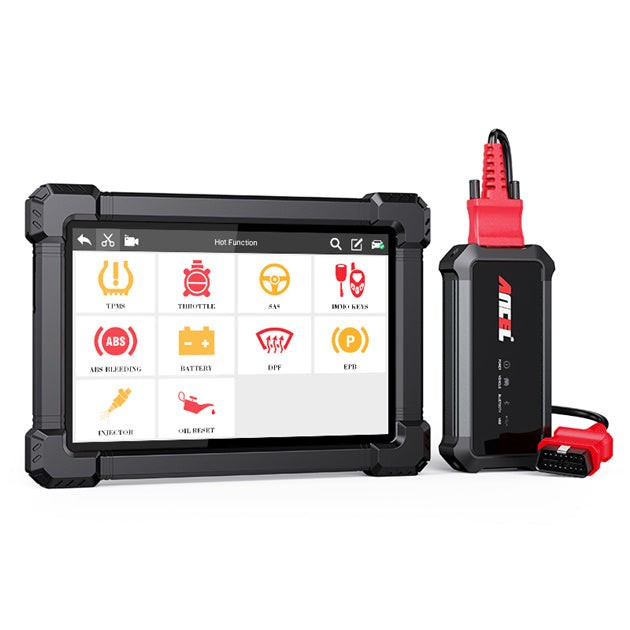The Toyota Corolla, including the Corolla Cross Hybrid, is equipped with an OBD2 (On-Board Diagnostics II) port. This allows you to use an OBD2 scanner to diagnose potential issues with your vehicle’s engine, emissions, and other systems, including hybrid-specific components. This comprehensive guide will explain everything you need to know about using an OBD2 scanner on your Toyota Corolla.
Locating the OBD2 Port on Your Toyota Corolla
The OBD2 port on a Toyota Corolla is typically located under the dashboard on the driver’s side, near the steering column. It’s a standardized 16-pin connector. You might need to bend down or use a flashlight to locate it.
 OBD2 Port Location
OBD2 Port Location
Choosing the Right OBD2 Scanner for Your Toyota Corolla
Different OBD2 scanners offer varying levels of functionality. Here’s a breakdown to help you choose:
- Basic OBD2 Scanners: These affordable scanners can read and clear basic fault codes. Suitable for checking engine light issues and simple diagnostics. Good for beginners.
- Bluetooth OBD2 Scanners: These wireless scanners connect to your smartphone or tablet via Bluetooth. They provide real-time data, user-friendly apps, and often more advanced features than basic scanners.
- Hybrid-Specific Scanners: If you own a Corolla Cross Hybrid, consider a hybrid-specific scanner. These tools offer in-depth insights into hybrid system components like battery health, energy flow, and regenerative braking performance.
Using an OBD2 Scanner on Your Toyota Corolla
Once you’ve chosen your scanner, follow these steps:
- Locate the OBD2 port: As mentioned, it’s usually under the dashboard on the driver’s side.
- Connect the scanner: Plug the scanner firmly into the OBD2 port.
- Turn on the ignition: Turn the key to the “on” position (or accessory mode, depending on the scanner). Do not start the engine.
- Retrieve data: Power on the scanner and use its interface or a connected app (for Bluetooth scanners) to read diagnostic trouble codes (DTCs) and live data.
- Interpret codes: Use the scanner’s built-in database or an online resource to understand the meaning of the DTCs. This will help you pinpoint the issue.
Benefits of Using an OBD2 Scanner on a Toyota Corolla
- Save Money: Diagnose problems yourself before taking your car to a mechanic, potentially saving on diagnostic fees.
- Preventative Maintenance: Identify potential issues early on and address them before they become major problems, saving on costly repairs.
- Improved Understanding: Gain a deeper understanding of your vehicle’s performance and health, especially with hybrid-specific scanners for Corolla Cross Hybrid owners.
- Convenience: Easily check your car’s systems at home or on the go with a portable OBD2 scanner.
Understanding OBD2 Codes on Your Toyota Corolla
OBD2 codes are standardized. The codes start with a letter:
- P: Powertrain (engine, transmission, emissions) – Most common for general car owners.
- B: Body (airbags, power seats, central locking)
- C: Chassis (ABS, suspension)
- U: Network communication
Conclusion
An OBD2 scanner is a valuable tool for any Toyota Corolla owner, whether you have a standard gasoline engine or a hybrid. It empowers you to understand and address potential issues, saving you time and money in the long run. Choosing the right scanner depends on your needs and technical proficiency, but even a basic scanner can be incredibly helpful for diagnosing common problems.
FAQs
Can a standard OBD2 scanner diagnose hybrid-specific issues on a Corolla Cross Hybrid?
Basic scanners can read generic powertrain codes, but for in-depth hybrid system diagnostics, a hybrid-specific scanner is recommended.
Where can I find a reliable OBD2 scanner for my Toyota Corolla?
OBD2 scanners are available at most auto parts stores, online retailers, and specialized automotive tool suppliers.
What should I do if my OBD2 scanner doesn’t connect to my Corolla?
Check the connection, ensure the ignition is on (but the engine is off), and consult the scanner’s manual for troubleshooting steps. Make sure the OBD2 port’s fuse is not blown.
